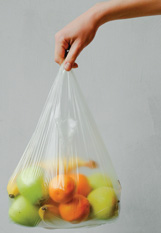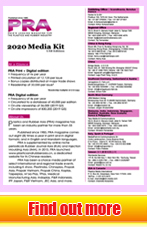Plastics under the pandemic lens
The Covid-19 pandemic has revealed the best and the worst of plastics (and rubber) use. Meanwhile, stemming a post-pandemic onslaught of waste, recycling is by far the best solution offered by industry experts, says Angelica Buan in this report.
Plastics: on the winning end in pandemic
The Covid-19 pandemic has bolstered the use of plastics even more in the healthcare and retail space, and it is no denying the fact that plastic as a material has had its shining moment during this pandemic.

According to a study by Dr David Fengwei Xie, a Marie Sklodowska-Curie Fellow at the University of Warwick, UK, the pandemic has shown that plastic is indispensable, especially for health safety, with demand rising for medical devices and personal protective equipment (PPE), all of which are either made of or have significant components of plastic materials.
Meanwhi le, Dmi t ry Konov, Chai rman of the Management Board of Russian petrochemicals company Sibur, says in an article published by the WeForum that how plastics have remained “the most reliable and affordable solution for personal protection, “considering its role in safety protection during the Covid-19”. He said that polymers have been perceived as a valuable material for the production of disposable plastic packaging and medical personal protective equipment during the pandemic.
Waste generation to contend with
Thus, a future of more plastic is likely, according to Xie. But increased use of plastics abets greater waste generation, and spawns the build-up of plastic pollution.
Since 2018 when China started the ban on plastic waste imports, developed countries have been in a movement to reduce plastic wastes. Goals have been set to eliminate single-use plastic items such as bags, straws and cutlery. Besides, there have been discussions regarding the reduction of plastic wastes from laboratories and hospitals.
However, under the influence of the unprecedented Covid-19 pandemic starting in early 2020, the industry may now need to re-think the question: Is the future more plastic? And although the pandemic is temporary, the resulting pollution is “long-lasting”, Xie said.
Two sides to plastics use: health or environment
Now, the situation presents two sides: protecting health or the environment; a choice between the devil and the deep blue sea.

Xie cites gloves as an example of PPEs that have witnessed staggering demand during this period. Relatedly, gloves, which are made of rubber, are essential for health care workers, he said. Xie explained that while latex gloves are biodegradable because the polymer is extracted from rubber trees, but nitrile and vinyl gloves made from synthetic polymers are not biodegradable.
In this respect, choosing latex gloves may have smaller environmental impediment than their synthetic non-biodegradable counterparts. But health issues like allergic reactions linked to using latex gloves also hinder their preferential use.

“In this sense, if only latex gloves are used by health workers, fighting the disease is unlikely to cause much environmental pollution. However, there are many other health-related items that are made of synthetic polymers and thus are not so environmentally friendly,” says Xie.
Surgical masks are another example, whereby the mos t important material to make surgical masks is melt-blown PP, which can effectively shield microbes and droplets, Xie said. For the same reason, non-woven PP is also widely used to make protective clothing for medical staff.
Likewise, syn thetic polymers such as PVC and PP, and which are not biodegradable, are used in medical applications such as pill casings, disposal syringes, catheters, and blood bags , according to Xie.
“Therefore, it would be not surprising to see that the Covid-19 pandemic is generating tonnes of medical waste,” he said.
Social distancing increases use of plastic products
Coronavirus containment protocols including quarantine, isolation and social/physical distancing are meant to flatten the infection curve. Incidentally, such measures promote the use of more disposable plastic items for hygiene; and particularly social/ physical distancing, which has seen increased use of disposable gloves.
Disposable PE gloves are more commonly used by people going outside for shopping or other purposes where they need to avoid touching surfaces, pointed out Xie in his study.

“PE is the same polymer used for plastic shopping bags worldwide, which has already caused tremendous envi ronmental i s sues ,” he added. “Dur ing the lockdown, many people are also ordering more food deliveries and takeaways, which means increasing amounts of disposable meal boxes are being used, which are commonly made of PP or PS,” he said, explaining how the “fear over the coronavirus” has spurred the use of more plastic than usual.
For this reason too, plastic bans have been pushed aside, particularly in England, some states in the US and South Australia, to allow for a more liberal use of plastics to reduce the coronavirus risk.
In a similar note, a 2013 study by Dr Ryan Sinclair at Loma Linda University School of Public Health confirmed that reusable grocery bags, when not properly disinfected, can be carriers for bacteria and viruses, including norovirus and coronavirus.
On the basis of this finding, the study suggested that although these reusable bags (including those promoted for use in supermarkets and retail shops) are not exempted from contamination, they are still “environmentally friendly” as they can be reused after washing thoroughly to reduce bacteria by nearly 100%.
Meanwhile, in a more recent study published in 2018 in the Journal of Environmental Health, Sinclair and his team also found that reusable bags can transfer pathogens around at supermarkets. The study says pathogens are passed on from store employees and shoppers, especially at high contact points like checkout conveyors, food scanner and grocery carts.
Thus, during this virus outbreak, single-use plastics are preferred over reusable ones.
Containing pandemic-generated waste with recycling
Aside from waste generated during the pandemic, the plastic waste problem has been a long standing concern. To counter this, sectors have turned to recycling as the sum and substance of an efficient waste management.
But with the recent drop in oil prices, virgin plastics could be cheaper and might further harm the viability of plastic recycling, says Xie. “With higher amounts of plastic used and reduced recycling capability in this trend, unfortunately, we are likely to see more plastic waste or more plastic pollution,” he adds.
The global recycling rate has remained low at less than 10%, or about 6,300 million tonnes of waste, according to a study by the University of Georgia. This finding, released in 2018, has not been superseded with newer figures that would tell whether recycling rates have improved or not since then.
Adding further to the lower recycling rate is the current pandemic. According to Xie’s findings, the lockdown measures have “hampered our ability to process recyclable waste properly”. It has also posed risks to waste recycling workers, he added.
More waste, less recycling
The Asian Development Bank (ADB), in a recent report, acknowledges the fact that the pandemic “is producing more household waste and increased amounts of dangerous medical waste”.
In Hubei province, China, dur ing the Covid-19 outbreak, infectious medical waste increased by 600% from 40 tonnes/day to 240 tonnes/day, overwhelming existing medical transport and disposal infrastructure around hospitals, the ADB reported.
ADB’s report titled Managing Infectious Medical Waste during the Covid-19 Pandemic also gleaned that other countries will face similar challenges. It recommended for addi t ional waste management systems to be put in place to help reduce the further spread of Covid-19 and the emergence of other diseases.
The pandemic, the Manila-based financial agency said, has altered the ways on how waste is managed.
If the waste management industry is unable to keep pace, Covid-19 could set back efforts to reduce and eliminate single-use plastics and recycling waste, it said.
Looking for solutions to impede waste/pollution
While, admittedly, plastic is indispensable, plastic pollution could be long lasting. So what can be done to minimise the negative impact of plastic on the environment?

While reducing or even avoiding the use of unnecessary plastic could definitely help to reduce plastic waste, using disposable plastic items in many cases remains an important option particularly for hygiene and convenience purposes.
However, using disposables does not necessarily mean more pollution, says Xie in hi sstudy. Boomerang Alliance’s Plastic Free Places programme has provided a guide to cafes and restaurants of how to avoid single-use plastics and what compostable packaging alternatives are available.
Disposables can be made from biomass resources or of biodegradable or compostable plastics. “ Biodegradable ” plastics can decompose into small molecules with the action of living organisms in the natural environment (such as in soil).
For “compostable” plastics to break down into simpler chemical compounds, composting facilities with controlled conditions (e.g., added nutrients and certain temperature) are required. Polylact ide (PLA) is a compostable bioplastic made from the sugars from fermented starch (e.g., corn and cassava), sugarcane or sugar beet.
Polyhydroxyalkanoate (PHA) is a biodegradable polymer produced by microorganisms (bacteria) from organic matters like sugar or lipids. There are many biomass resources such as cellulose, chitin/ chitosan, starch, lignin, and alginate, which can be used to make biodegradable materials, too.
Xie says that other than developing biodegradable or compostable plastics, there is so much that needs to be done.
“Plastic waste is much more complex than fighting Covid-19 and it needs governments, NGOs, industry, researchers, and the public to work together to form synergistic approaches,” he says.
Meanwhile, ADB says continuing efforts should be made to reduce single-use plastics and efforts taken in recycling, adding that it “is imperative to keep the waste and recycling facilities operational”.
Further to this, Sibur’s Konov opined that unless technological advances introduce bet ter alternatives, “a systems-level approach is needed from companies and government s on a global scale to address the issue of plastic and protect our environment”.
Thus, Konov offers a solution that is to “encourage the production of polymers with improved recyclable qualities that would make it easier to reinsert used plastics back into our economy”.
He said this can be achieved by companies and businesses that will pursue “a proact ive role in decreasing pollution, while also highlighting critical benefits that industries could deliver to social comfort and safety.”
(PRA)
Subscribe to Get the Latest Updates from PRA Please click here
©2020 Plastics and Rubber Asia. All rights reserved.

©2020 Plastics and Rubber Asia. All rights reserved.
Home Terms & Conditions Privacy Policy Webmail Site Map About Us



















